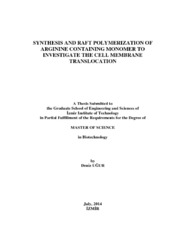Please use this identifier to cite or link to this item:
https://hdl.handle.net/11147/4199| Title: | Synthesis and Raft Polymerization of Arginine Containing Monomer To Investigate the Cell Membrane Translocation | Other Titles: | Hücre Membranından Translokasyonu İncelemek için Arjinin İçeren Monomerin Sentezi ve Raft Polimerizasyonu | Authors: | Uğur, Deniz | Advisors: | Bulmuş Zareie, Esma Volga | Keywords: | Radical polymerization Biopolymers |
Publisher: | Izmir Institute of Technology | Abstract: | In this study, a higly cationic biosynthetic polymer, poly(Arginine Methyl Ester Methacrylamide) (p(AMME)) has been designed as a potential component of intracellular delivery systems for biological macromolecular therapeutics such as nucleic acids. Accordingly, an arginine derivative monomer; Arginine Methyl Ester Methacrylamide (AMME) was synthesized by the reaction of an active ester monomer, pentafluorophenylmethacrylate (PFMA) and the L-arginine methyl ester hydrochloride (AME) in the presence of excess triethyl amine. AMME was then polymerized via both conventional free radical polymerization and reversible addition-fragmentation chain transfer (RAFT) polymerization. The polymers p(AMME) were characterized via nuclear magnetic resonance and gel permeation chromatography techniques. The conventional free radical polymerization experiments yielded polymers with uncontrolled molecular weights and wide molecular weight distribution, whereas RAFT polymerizations performed both in aqueous solution and organic solvent yielded polymers with controlled molecular weights and narrow molecular weight distributions. The RAFT polymerization kinetic experiments showed the RAFT-controlled character of AMME polymerization in the presence of 4-cyano-4-(ethylthiocarbonylthioylthio) sulfanylpentanoic acid (ECT) as a RAFT agent. The cytotoxicity of P(AMME) before and after aminolysis was determined via MTT assay using A549 human lung cancer cell line. P(AMME) before aminolysis of the RAFT end-group displayed dose-dependent toxicity after 24 hours incubation with cells. It was highly toxic to cells at 25 μM concentration, killing almost more than 60% of cells after 24 hours incubation. On the other hand, the aminolyzed polymer has no significant toxicity in the concentration range studied (upto 500 μM), which was comparable with octaarginine, a widely used transfection agent. In conclusion, well-defined arginine-polymers synthesized in this study show potential for further investigations as potential components of intracellular delivery systems for therapeutics. | Description: | Thesis (Master)--Izmir Institute of Technology, Biotechnology, Izmir, 2014 Includes bibliographical references (leaves: 53-58) Text in English; Abstract: Turkish and English x, 58 leaves |
URI: | http://hdl.handle.net/11147/4199 |
| Appears in Collections: | Master Degree / Yüksek Lisans Tezleri |
Files in This Item:
| File | Description | Size | Format | |
|---|---|---|---|---|
| 10047117.pdf | MasterThesis | 2.39 MB | Adobe PDF |  View/Open |
CORE Recommender
Page view(s)
63,032
checked on Apr 21, 2025
Download(s)
244
checked on Apr 21, 2025
Google ScholarTM
Check
Items in GCRIS Repository are protected by copyright, with all rights reserved, unless otherwise indicated.